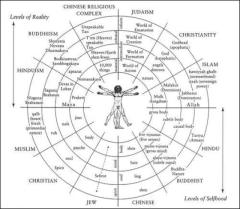
Figure 1: Diagram by Brad Reynolds, from Ken Wilber, A Brief History of Everything, (Shambhala: Boston), 1996.
This semester, I find myself contributing to a number of university courses. One is Metaphysics. As designed by my colleague, the class moves between classical metaphysics (what we have thought about Being in the past) and transhumanist metaphysics (what human being may become in the future). After some Plato and Aristotle, the path of the class moves between Heidegger’s Introduction to Metaphysics and Steve Fuller’s Humanity 2.0.
I like this approach a great deal. I dare say, I was brought on board because I spend my time considering the diverse ways ancient traditions of the Axial Age first circumscribed the questions we still ask about Being today.
Nonetheless, my love of science fiction and fantasy always causes me to wander (or wonder) forward as well. The works of Frank Herbert and Neil Stephenson play a large role in these kinds of meanderings for me. Each represents a hero or set of heroes who go forward in the recognition of the need for communication and community.
Being an anarchocynic, communication drives philosophizing: discovery of our path is a group endeavor. Finding our way requires more than solitary exploration and listening to one or two experts who dominate the conversation.
Of course, as Jaspers notes, “Philosophy has been wrought by lonely distant individuals.” Yet the meandering course of human history shows many turns toward the creation of communities–monasteries and colleges–to promote cooperative thinking. These collections not only sought a quiet life of contemplation and research but an active life of knowledge production and even contributed to political policy. Such communities first get a foothold during the previously mentioned Axial Age.
Every bend in the flowing river of human transformation has a communal port for necessary exchange.
In my own life, before spending two decades at the University of North Texas, there was a brief time with a religious order and myriad visits to discuss with monks, nuns, priests, senseis, gurus, and many others across diverse traditions. This has become a practice for me to this day: to consult with those who live in community about the future of our living together. How do we go forward from where we originated?
When I speak to younger people just getting underway, there is a realization that by having less experience of the great traditions, dialog must begin from where they are. Hopefully a path opens up where they will find the most helpful study. So I try to move between the classical texts and newer stories. Youth know at least some of the classics and usually are quite familiar with current fictions. Both give us fodder to consider how seeking the beginning often discloses our destination.
I find a great deal to work with in the Star Wars mythos as it pertains to a community of both scholarly and pragmatic seekers. First, most if not all youth know the basic stories. Furthermore, many of the plot lines highlight a struggle between those who work together for the common good and those who are directed by a leader who confuses his own desire for the desire of everyone. The community always evidences root in an origin or a tradition. The tyrant usually relates to the past only enough to demonstrate how his vision of tomorrow would correct all the bad that had happened before.
Such fiction reveals a significant ability: We can seek ahead and we can seek behind. Seeking ahead projects beyond our present to what may be. Seeking behind rejects beyond our present to what may have been. I say rejects, because a successful looking-backward will change the way we see ourselves today by throwing-us-back to reconsider our own history. (Nota bene: seeking behind in order merely to justify why we should go a new direction often is a pure rejection that closes the present off entirely from the interconnected elements (rhizomes) that brought it into being.)
The prequel in fiction is a good way of examining how we tell narratives of origin. In some instances, we are only concerned with previous generations. Other times we are looking for what the Greeks called the ἀρχή (ARCHE).
So making a prequel, in my way of thinking, matches what any philosopher or theologian or scientist does in the speculation to our origin. Star Wars, as franchise and myth, has grown its universe by the continued use of prequels and sequels to the films we have all watched over the course of the last 35 or so years.
As an example: Dark Horse Comics Dawn of the Jedi—by writer John Ostrander and Artist Jan Duursema–starts with the gathering of Force sensitive sentients on the planet Tython in 36,453 BBY (Before the Battle of Yevin or the Destruction of the First Death Star in Episode IV: A New Hope).
Figure 4 shows a Tho Yor, a giant and ancient pyramidal structure which turns out to be a Star Ship. As of now, it is never clarified if the structure was created by the Oldest Force entities, the Ones, or some newer—though still vastly older civilization—than those with which we are familiar in the Star Wars films.
Here is a brief overview from Wookiepeedia:
…the Talid monks of the Order of Dai Bendu on the planet Ando Prime feel the call of the Tho Yor… that has been buried in the Andobi Mountains for centuries. The Dai Bendu monks board the Tho Yor as seven other Tho Yor across the galaxy call out to the natives of the planets upon which they rest; the Tho Yor then travel the galaxy and visit other planets, gathering Wookiees, Humans, Twi’leks, Selkath, Cathar, and a number of other Force-sensitive species [even Sith], before all eight travel to the planet Tython in the Deep Core. There, the eight Tho Yor gather around the ninth and largest Tho Yor, which floats above a pinnacle of stone, and the starships scatter themselves across Tython as the planet is engulfed in a ferocious Force Storm.[2]
The pilgrims come to realize that they have been brought to Tython to study the Force, and they form the Je’daii Order—an order of warriors and scholars whose name is a Dai Bendu word meaning “mystic center.” Tython is a planet that reacts violently to imbalance in the Force, so the Je’daii develop a philosophy of balance between the light and dark sides of the Force, which they name after the twin moons of Tython: bright Ashla and dark Bogan. (see Figure 2 below)
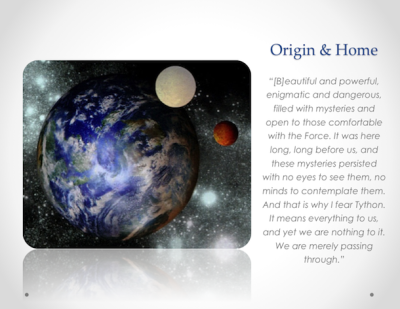
Figure 5: Origin & Home – Tython http://starwars.wikia.com/wiki/Tython
Obviously, in a tale like this one, we are seeing artists pull together not only imagery but even terminology from the world’s religions and philosophies, e.g. Tho Yor is Tibetan for stones stacked in a pyramidal shape. After all, we can only imagine the extraordinary by how willing we are to vary or to play with the ordinary. Such playfulness is the heart and soul not only for making fiction but of doing thought experiments.
The Dawn of the Jedi origin story concentrates on the need to find the balance between the light and the dark. This does not mean existence on a stale middle ground but recognition that every action must be made with the most rigorous precision. It also paints very clearly that anything each of us decides to do will have both immediate and lasting effects on those around us.
The storyline rejects the notion that following the Force requires that one side must defeat the other. Rather, engagement in the world–engagement with natuer and with each other–necessitates learning how to envision as well as to accomplish dynamic equilibrium. With nature, this is done through careful inhabitance, being mindful of our dwelling. With each other, this is done through careful habit, being open to dialog. Each teaches us to take full responsibility for what we do and what we think.
Today, dwelling surrenders as progress dominates; dialog wains as polemic waxes. I believe this concerns the violent separation of theory from practice. Before the late middle ages in the Western tradition, there was never much of a question that contemplation was an active practice, nor that it always leads back to the way we engage the world through meaningful actions.
If I may repeat myself: Contemplating, theorizing, theoria is a kind of praxis. More importantly, it often leads to newer, better actions and more comprehensive knowledge because it is only in the contemplative that we can entertain the counterfactual.
And all seeking behind and ahead must, in some way, make use of the counterfactual. This is because–despite our very best efforts–we do not have all of the data that makes up the world. Thus, our facts–drawn together from the data we have collected–are themselves limited. No matter how well may have ordered our facts into a convincing presentation of information, we can never say we have full knowledge. So any looking ahead that does not look back should be seen for what it is: carelessness.
In re-imagining a beginning–be it fictional prequel or factual origin–we must overcome the divisive judgment that theoretical or contemplative practice is somehow merely speculative and without pragmatic end. This is nothing less than the slavery to the factual, and often contributes to the adoption of uncritical thinking if not providing excuses for a destructive future.
Though it did take some convincing, many have been brought on board with the counterfactual notion that the earth is moving around the sun. Counterfactual, in this case, because we daily deal with the fact that the earth does not appear to be moving while the sun rises in the east and sets in the west. This was a contemplative exercise by Copernicus and his fellows which lead to the gathering of new facts by the likes of Galileo. All of this has lead to new ways of looking at our world and ourselves.
Still, there was push back in the beginning. When we are comfortable with how things appear to be, there is a strong impulse to continue forward in that comfort. Since the days of Galileo, we have moved from claims of infallibility in the institution of the Church to claims of inerrancy in the actual text of the Holy Bible. These claims are facts that ground the worldview of many people. They provide an intellectual security zone that eschews rational critique. Thus, marriage as traditionally practiced has become a notion where many cannot see beyond the fact of procreational duty. “God made Adam and Eve, not Adam and Steve” is put forward as a factual statement. And while it may seem strange to say so, belief in the seven day creation of the world by Yahweh is considered “fact”.
Obviously, these uses do not fit the standard definition of fact among scientists or even lawyers. But the everyday world in which folks make-do with what they have is informed by more than science.
Talking about these issues in conjunction with Star Wars invites the recognition that a story is being compared to a story. Allegory and metaphor are being compared with allegory and metaphor. The problem here, and it is no small one, is finding the balance between how things appear now and how they could have been or will be. That is, the harmony of actuality and possibility.
Therefore, looking at such stories is only a means to thinking about thinking while getting youth to see the origins they are used to accepting as also open to question.
I am not turning to Star Wars to demonstrate a moral. Rather, I touch base with such popular stories to engage youth in creative critique as they learn more about our ancient search for an ARCHE, see our present circumstances, and imagine a future direction or TELOS for humanity. Such an endeavor explores via a kind of existential thinking about our way through the world and as expressions of Being.

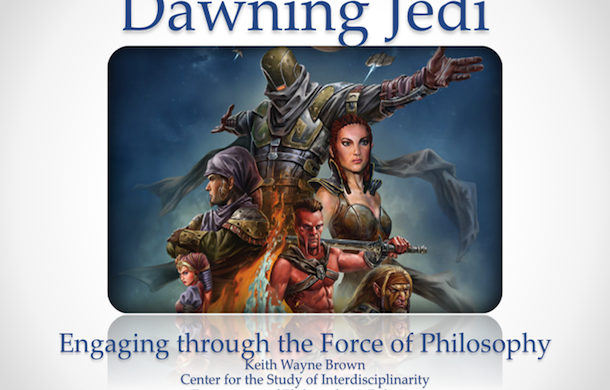

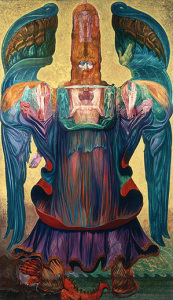

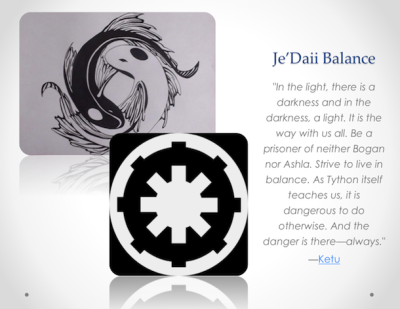
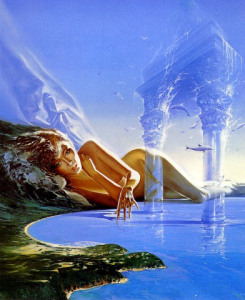
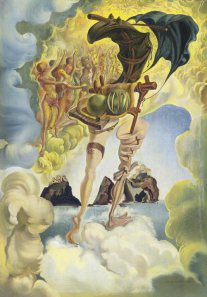
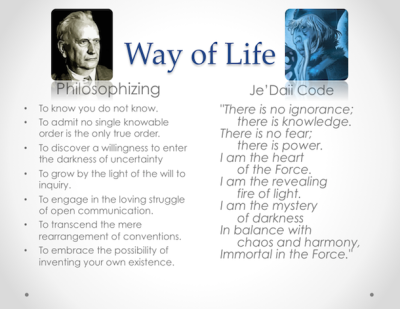
Pingback: Philosophy In the Town Square | Reason & Existenz